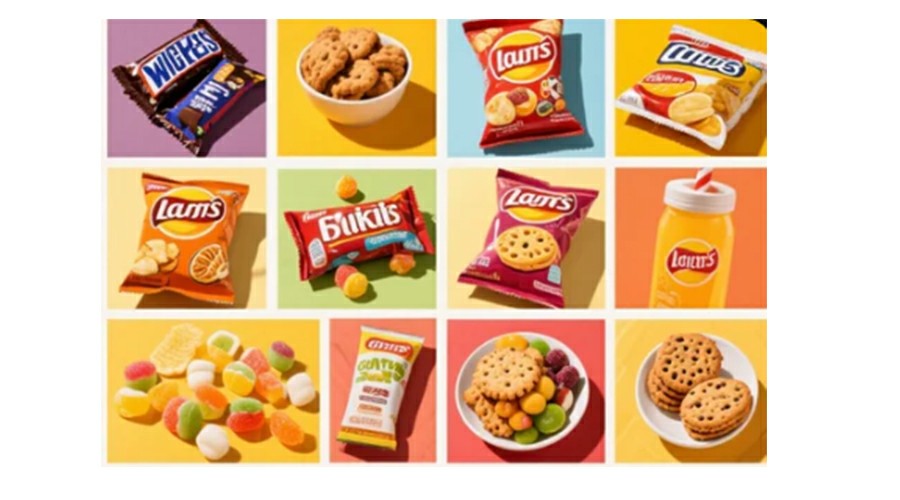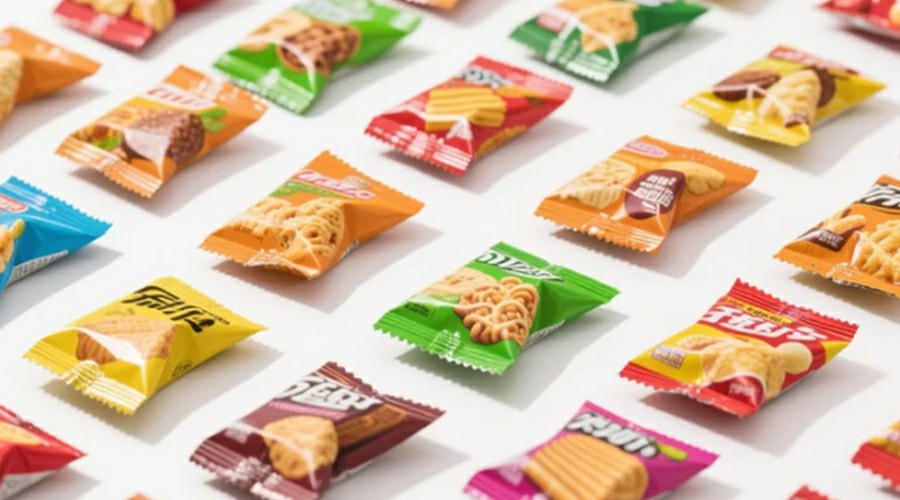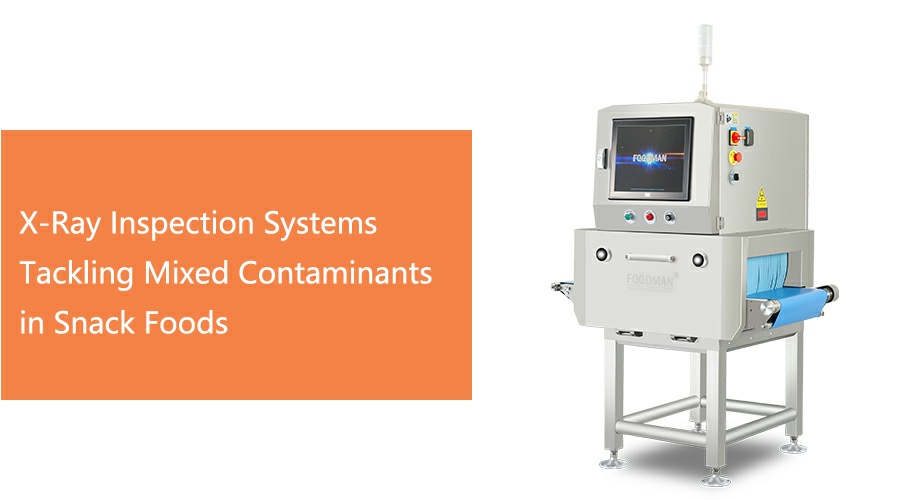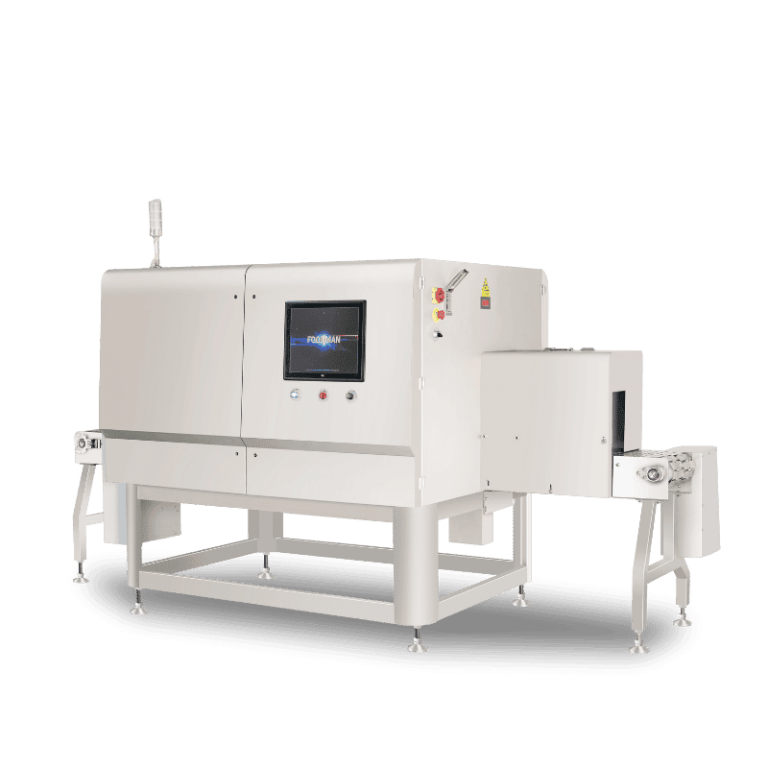Introduction: The Rising Demand for Safer Snack Products
Global Snack Consumption Trends and Safety Expectations
The global snack market is experiencing rapid growth as consumers increasingly seek convenient and diverse food options. Along with this surge, there is a heightened demand for safer, higher-quality snack products. Consumers today not only prioritize taste and variety but also expect rigorous safety standards to ensure their snacks are free from harmful contaminants. To meet these expectations, manufacturers are turning to advanced technologies like X-Ray inspection to enhance product safety and quality assurance.

Challenges of Maintaining Quality in High-Speed, High-Volume Snack Production
Producing snacks at high speeds and large volumes presents significant quality control challenges. The fast pace increases the risk of foreign material contamination such as metal fragments, glass shards, stones, and plastics. Traditional inspection methods often struggle to detect all types of contaminants effectively, especially non-metallic ones or those hidden within complex snack mixtures. Additionally, the variety of packaging materials and forms complicates thorough inspection. To overcome these challenges, many manufacturers rely on sophisticated X-Ray inspection machines that deliver reliable detection without compromising production efficiency.
The Role of X-Ray Inspection Systems in Addressing Contamination Risks
The integration of X-Ray inspection systems has revolutionized contamination control in snack food manufacturing. Unlike conventional metal detectors, food X-Ray inspection equipment uses density-based imaging to identify a wide spectrum of foreign objects, including metals, glass, stone, and dense plastics, even if embedded within products or packaging. These systems provide real-time, non-destructive inspection, ensuring contaminated items are detected and removed swiftly from the production line. The adoption of X-Ray inspection machines enhances food safety compliance, reduces product recalls, and strengthens consumer trust—making it an indispensable tool in today’s snack production environment.
Understanding Mixed Contaminants in Snack Foods
Common Foreign Bodies: Metals (Ferrous, Non-ferrous), Glass Shards, Stones
In snack food production, one of the most frequent and dangerous quality issues is the presence of foreign bodies. Metal fragments, whether ferrous or non-ferrous, often result from equipment wear or processing mishaps. Glass shards may enter through broken containers or ingredient handling, while stones can be introduced with raw agricultural materials. These types of contaminants are serious safety hazards and must be effectively identified by advanced X-Ray inspection systems. Compared to conventional metal detectors, X-Ray inspection machines offer the ability to detect both metallic and non-metallic objects based on density differences, providing broader protection for snack products.
Packaging-Related Contaminants: Plastic, Rubber, Sealing Tape
In high-speed packaging lines, materials such as plastic clips, rubber gaskets, or sealing tape residues can sometimes get mixed into the product. These contaminants are often overlooked by traditional inspection technologies due to their low conductivity and non-metallic nature. However, food X-Ray inspection can detect these materials by assessing density contrast, even when they’re embedded within multi-layer snack products or opaque packaging. A robust X-Ray inspection system ensures these invisible threats are caught before the product reaches consumers.
Product-Originated Fragments: Bone, Shell, Burnt Material
Some contaminants originate from the snack product itself—such as bone fragments in meat-based snacks, shell pieces in nut mixes, or burnt material from baking or frying. These are especially challenging to spot visually or through traditional mechanical sorting. X-Ray inspection equipment excels in such scenarios by creating a grayscale density image that highlights irregularities within the product’s composition. This allows for more precise and consistent contaminant detection in real time.
How Mixed Contaminants Complicate Detection
When multiple types of contaminants—metallic, non-metallic, and organic—are present in the same production environment, detection becomes increasingly complex. Each material reacts differently to traditional inspection methods, leading to higher risks of false positives or missed detections. X-Ray inspection provides a unified solution by identifying all high-density anomalies, regardless of their composition. Modern X-Ray inspection machines equipped with advanced software can distinguish between safe inclusions (like nuts or seasoning clusters) and harmful contaminants with high accuracy. This makes X-Ray inspection systems an ideal choice for snack food producers aiming to ensure product safety while minimizing unnecessary waste.
Why Traditional Methods Fall Short
Metal Detectors: Limited to Conductive Materials
Metal detectors have long been a staple in food manufacturing lines, including snack food production. However, their capabilities are inherently limited—they can only identify conductive materials, such as ferrous and some non-ferrous metals. Contaminants like glass shards, stones, dense plastic, and rubber particles cannot be detected by metal detectors. This leaves a significant blind spot in quality control. In contrast, X-Ray inspection systems operate based on density rather than conductivity, making them far more versatile. A well-calibrated X-Ray inspection machine can detect a broad range of foreign bodies that metal detectors simply cannot identify.
Visual/Manual Inspection: Inconsistent and Inefficient
In some snack production facilities, visual inspection or manual sorting is still used for quality assurance. While human inspection has value in niche scenarios, it is prone to fatigue, inconsistency, and error—especially at high production speeds. Small or embedded contaminants can easily go unnoticed, and inspection outcomes may vary by operator. X-Ray inspection equipment, on the other hand, delivers automated, real-time screening with repeatable precision. This greatly enhances efficiency and eliminates subjectivity, allowing manufacturers to maintain consistent quality in every batch.
The Need for Advanced, Multi-material Detection Technologies
Snack foods often come in complex formats—mixed textures, varied densities, and multilayer packaging. As contamination risks increase, there’s a clear need for inspection technologies that can reliably detect foreign materials of multiple types and densities. This is where food X-Ray inspection proves its value. Modern X-Ray inspection systems equipped with dual-energy imaging and adaptive algorithms can distinguish between bone, plastic, glass, and even burnt food particles. The advanced capabilities of these systems offer a unified solution for manufacturers facing the challenge of mixed contaminants. Integrating a high-precision X-Ray inspection machine at the end of the production line ensures that snack products meet safety and quality standards before reaching consumers.
How X-Ray Inspection Systems Address Mixed Contaminants
Density-Based Detection for All Material Types
Unlike traditional inspection technologies that rely on conductivity or surface-level appearance, X-Ray inspection systems operate on the principle of density detection. This allows them to identify a wide variety of contaminants—including metal, glass, stone, rubber, and plastic—regardless of their composition. A modern X-Ray inspection machine captures grayscale images based on how different materials absorb radiation, enabling manufacturers to detect even non-metallic threats in snack foods. This makes food X-Ray inspection an ideal solution for mixed-contaminant scenarios.
Real-Time Inspection of Sealed, Multi-layered Packaging
Many snack products today are packaged in sealed, multi-layered bags or pouches, which pose a challenge for visual or metal detection methods. However, X-Ray inspection equipment excels in scanning through complex packaging materials such as aluminum film, laminated plastics, and foil wraps. Whether inspecting potato chips in metallic bags or nut bars in vacuum-sealed trays, a high-performance X-Ray inspection system offers real-time, non-destructive inspection that doesn’t require unpacking or slowing down the production line.

Dual-Energy X-Ray Systems for Enhanced Contrast and Material Differentiation
Advanced X-Ray inspection machines often come equipped with dual-energy technology, which captures two images at different energy levels. This enables the system to differentiate between materials with subtle density differences—such as distinguishing bone from plastic, or shell fragments from burnt food particles. In the context of food X-Ray inspection for snack production, this feature dramatically improves detection accuracy and reduces false positives, especially in products with varied textures or coatings.
Detection of Contaminants Regardless of Location Within the Snack
Foreign bodies are not always on the surface; they can be embedded inside the product, such as a small stone within a nut cluster or a piece of plastic under a chocolate coating. X-Ray inspection systems can detect contaminants anywhere within the snack, no matter how deeply they are buried. The ability of X-Ray inspection equipment to analyze internal structure in real time gives manufacturers a comprehensive view of product integrity, ensuring consumer safety even when contaminants are hidden from sight.

Application Scenarios in Snack Production
Baked Snacks (Biscuits, Crackers, Cookies): Detection of Hard Particles and Dough Inclusions
Baked snacks are highly susceptible to foreign materials like hard plastic pieces, bone chips, or metal fragments introduced during dough mixing or rolling processes. Since these products are often light in texture and fast-moving on production lines, relying solely on visual checks or metal detectors may not be enough. Food X-Ray inspection offers a non-invasive solution that detects contaminants inside the product—even when they are embedded in dense dough or hidden under decorative coatings. By implementing a high-resolution X-Ray inspection machine, manufacturers can ensure the safety and consistency of biscuits, crackers, and cookies.

Fried Products (Potato Chips, Puffs): Detecting Rubber and Metal Fragments from Frying Equipment
Frying environments are particularly harsh on machinery, often leading to wear of rubber gaskets, seals, or metal scrapers. These fragments can unintentionally mix with snacks during frying or handling. X-Ray inspection systems are designed to identify such non-metallic and metallic foreign bodies, even when they are camouflaged by oil or product coloration. Because fried products are often packed in foil-lined bags, a traditional metal detector would be ineffective—whereas X-Ray inspection equipment can easily penetrate such packaging. This makes food X-Ray inspection an essential part of quality control for chips, rings, and puffed snacks.

Chocolate-Coated Snacks and Bars: Identifying Hidden Glass or Stones
In chocolate-coated products, contaminants can be deeply embedded and completely invisible to the naked eye. For example, a small stone or piece of glass from raw ingredient processing may remain inside a nut cluster and become coated with chocolate. X-Ray inspection machines can detect these dense materials by scanning the internal composition of the bar without damaging the packaging. Advanced X-Ray inspection systems with dual-energy technology can distinguish between product components and contaminants, offering unmatched accuracy for manufacturers of chocolate bars, granola snacks, and filled wafers.
Mixed Packs or Combo Snacks: Verifying Each Component and Checking for Completeness
Combo snack packs—like those combining crackers, cheese spreads, and meat slices—present a unique challenge due to multiple product types and compartments. It’s critical not only to detect contaminants but also to verify product completeness and component placement. A sophisticated X-Ray inspection system can analyze each section of a pack, confirming the presence, alignment, and integrity of each item. By incorporating X-Ray inspection equipment at the end of the line, manufacturers reduce the chance of mispacked or unsafe products reaching consumers, thereby enhancing both quality and customer satisfaction.
Benefits of Implementing X-Ray Inspection in Snack Lines
Comprehensive Contaminant Detection from Start to Finish
Snack food production lines face diverse contamination risks—from raw ingredient handling to final packaging. Implementing a food X-Ray inspection process ensures that contaminants such as metal, glass, stones, rubber, and dense plastic are detected at every critical control point. Unlike traditional systems that may miss non-metallic hazards, a modern X-Ray inspection system offers comprehensive contaminant detection throughout the production lifecycle. Whether scanning raw dough, fried products, or sealed multipacks, X-Ray inspection machines provide complete oversight without interrupting production flow.
Minimizes False Positives While Maintaining High Accuracy
One of the key advantages of using advanced X-Ray inspection equipment is the ability to accurately identify true contaminants while minimizing false rejects. Traditional methods like metal detectors may falsely flag harmless components (like salt clumps or spices), resulting in unnecessary waste. In contrast, X-Ray inspection systems leverage density-based detection and intelligent imaging to clearly differentiate between safe product elements and harmful foreign bodies. This reduces product loss, improves line efficiency, and ensures only truly defective items are removed.
Reduces Recall Risks and Protects Brand Reputation
In the highly competitive snack food industry, product recalls can have devastating financial and reputational impacts. Integrating a robust X-Ray inspection machine into snack lines acts as a safeguard against contamination-related incidents. By detecting and rejecting foreign materials before products reach the market, manufacturers can drastically reduce the risk of recalls. More importantly, X-Ray inspection builds consumer trust—demonstrating that the brand is committed to delivering safe, high-quality products every time.
Supports HACCP and GFSI-compliant Food Safety Programs
Global snack brands must meet stringent food safety regulations such as HACCP, BRC, IFS, and FSSC 22000. A well-configured X-Ray inspection system supports compliance by providing reliable, verifiable, and auditable inspection data. Many modern X-Ray inspection machines are equipped with features like data logging, image archiving, and auto-rejection tracking, all of which help enforce critical control points in line with food safety management systems. By incorporating food X-Ray inspection as part of a broader food safety strategy, snack producers not only meet regulatory requirements but also enhance operational transparency.
Choosing the Right X-Ray Inspection Equipment
Key Features for Snack Applications: Sensitivity, Belt Speed, Hygiene Rating
Snack food production often involves high-speed lines and diverse product types—ranging from light, fragile chips to dense, filled bars. Therefore, choosing the right X-Ray inspection equipment requires careful consideration of several performance attributes. First, sensitivity is crucial for detecting small contaminants like fragments of glass or rubber in thin products. Second, the belt speed of the X-Ray inspection machine must align with the production line’s throughput to avoid bottlenecks. Finally, because food safety is paramount, food X-Ray inspection systems used in snack production should feature hygienic designs, such as IP66-rated enclosures and tool-free cleaning, to ensure compliance with sanitation standards.
Importance of Flexible Software to Adapt to Product Changeovers
Modern snack production lines often switch between multiple product types and packaging formats. This creates a need for X-Ray inspection systems that can adapt quickly and maintain high accuracy without excessive downtime. Look for systems with intelligent software that offers auto-calibration, programmable product libraries, and easy recipe switching. These features ensure that the X-Ray inspection equipment remains efficient and accurate across changeovers—whether the product is a foil-wrapped chocolate bar or a tray of mixed snacks. A flexible X-Ray inspection system helps manufacturers maintain line productivity and avoid errors caused by incorrect settings.
ROI Considerations: Reduced Waste, Increased Uptime, Fewer Complaints
While investing in an X-Ray inspection machine may appear costly at first, the return on investment (ROI) becomes clear when viewed through the lens of operational efficiency. Accurate detection reduces product waste by minimizing false rejects. Reliable systems with fewer stoppages mean increased uptime, ensuring better throughput. Additionally, by preventing foreign materials from reaching consumers, food X-Ray inspection greatly reduces the risk of customer complaints, brand damage, and costly recalls. Over time, these benefits make high-performance X-Ray inspection equipment a strategic asset that pays for itself by enhancing both quality and productivity.
Conclusion: Keeping Snack Lovers Safe and Satisfied
The Value of Comprehensive X-Ray Inspection in a Competitive Snack Market
In a market where consumer expectations are at an all-time high, ensuring product safety is no longer optional—it’s essential. From chips and cookies to chocolate bars and combo packs, today’s snack producers must safeguard every bite. A robust X-Ray inspection system offers unmatched capability in detecting foreign bodies across diverse packaging and product types. By implementing a comprehensive food X-Ray inspection program, manufacturers gain not only protection from contamination-related recalls but also a powerful differentiator in an increasingly competitive landscape. The ability of X-Ray inspection equipment to detect contaminants like metal, plastic, glass, or bone across all stages of snack production adds significant value to quality control programs.
Final Thoughts on Building Trust Through Advanced Inspection
Brand loyalty in the snack industry is built on consistency, safety, and transparency. Consumers want to know that their favorite products are manufactured under the highest safety standards. Investing in a high-performance X-Ray inspection machine reinforces this promise. Unlike traditional detection tools, X-Ray inspection systems provide real-time feedback, reduce false positives, and enable producers to guarantee the integrity of every snack leaving the facility. Ultimately, brands that adopt advanced X-Ray inspection equipment send a clear message—they care about quality, consumer trust, and long-term reputation.
Future Outlook: AI and Automation in Snack Food Safety
Lorem ipsum dolor sit amet, consectetur adipiscing elit. Ut elit tellus, luctus nec ullamcorper mattis, pulvinar dapibus leo.
The future of food X-Ray inspection is intelligent and automated. Artificial intelligence is already being integrated into next-generation X-Ray inspection machines, enabling smarter detection algorithms that adapt to product variability and packaging complexity. Automated learning, predictive maintenance, and seamless integration with MES and QA platforms are transforming X-Ray inspection systems into proactive quality assurance hubs. As the snack industry continues to grow and diversify, X-Ray inspection equipment powered by AI and automation will play a critical role in maintaining safety while supporting operational agility and innovation.
FAQ
Q: What types of contaminants can X-Ray inspection systems detect in snack products?
A: X-Ray inspection systems can detect metal (ferrous and non-ferrous), glass shards, stones, dense plastics, rubber, bones, and even burnt particles based on their density, regardless of material type.
Q: How does food X-Ray inspection equipment handle sealed or multilayer packaging?
A: Advanced X-Ray inspection machines can scan through opaque, multilayered, or metallic packaging without opening, ensuring non-destructive, high-accuracy inspection.
Q: Can X-Ray inspection detect foreign objects hidden inside snacks, like inside chips or under coatings?
A: Yes. X-Ray inspection systems analyze internal density and can detect embedded contaminants anywhere within the product, even beneath chocolate coatings or inside dense clusters.


